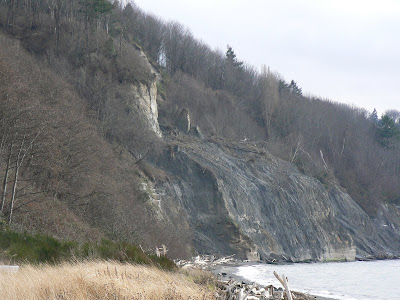Tucked in the upper reaches of Carkeek Park is an old orchard, planted by homesteaders in 1890 or so. For the past thirty years or so, volunteers, including the
Friends of Piper's Orchard have been tending it and planting more trees. About 15 of the original plantings remain, ancient breeds such as Wealthy, Red Astrachan,Gravenstein and Guyot Pear.
I watched a flock of about 70
pine siskins flutter around the orchard and then settle on a big tree at the back (a Rhode Island Greening, if I'm reading the
map correctly). It is a magnificent tree. Really, I should have lingered and taken a good portrait of it. But instead I took bad pictures of the birds...

...who promptly flew away.

Pine siskins spend their winters roaming around in flocks. Where they go depends on the supply of seeds. They seldom winter in the same area two years in a row. This year, they favored our region, and
showed up on in record numbers on the Christmas Bird Counts. They're fun to watch.
In his "Essential Field Guide Companion," Pete Dunne describes the pine siskin as "a quick, nervous, dark, drab, ultra-streaky pipsqueak of a bird that makes up in sass and belligerence what it lacks in size." Pete Dunne is fun to read.
Moving along a trail, a willow which fell down over the winter is still alive.

But then, it is hard to kill a willow. These are trees that evolved to coexist with beavers, ruthlessly efficient tree downers, who happen to find willow cambium delicious. But then there are plants that are tougher, such as the ivy still growing up the willow's trunk.

 Other birds come and go, chiefly black-capped chickadees and juncos. There's a flicker or a towhee from time to time, white-crowned and golden-crowned sparrows, Anna's hummingbirds, robins and roving flocks of bushtits or house sparrows.
Today the Boinks had new visitors: a pair of Steller's jays.
Other birds come and go, chiefly black-capped chickadees and juncos. There's a flicker or a towhee from time to time, white-crowned and golden-crowned sparrows, Anna's hummingbirds, robins and roving flocks of bushtits or house sparrows.
Today the Boinks had new visitors: a pair of Steller's jays.
 That got the scrub jays' attention.
That got the scrub jays' attention.


 For a few minutes the two sets of jays hopped around each other. The Steller's Jays looked very fluffy of feather, as if they were trying to seem big.
Eventually the scrub-jays started flying at the Steller's Jays. Three or four skirmishes, and the Steller's Jays flew across the street. One of the Boinks sat on the power line yelling after them.
Later on, the chitter of a flock of chickadees and juncos turned to alarm calls, and found another new bird sitting on my fence.
For a few minutes the two sets of jays hopped around each other. The Steller's Jays looked very fluffy of feather, as if they were trying to seem big.
Eventually the scrub-jays started flying at the Steller's Jays. Three or four skirmishes, and the Steller's Jays flew across the street. One of the Boinks sat on the power line yelling after them.
Later on, the chitter of a flock of chickadees and juncos turned to alarm calls, and found another new bird sitting on my fence. It's a young sharp-shinned hawk, a predator of small birds. The boinks weren't around when it settled on the fence, and it didn't stay long. I wonder if I'll see it again.
It's a young sharp-shinned hawk, a predator of small birds. The boinks weren't around when it settled on the fence, and it didn't stay long. I wonder if I'll see it again.

















